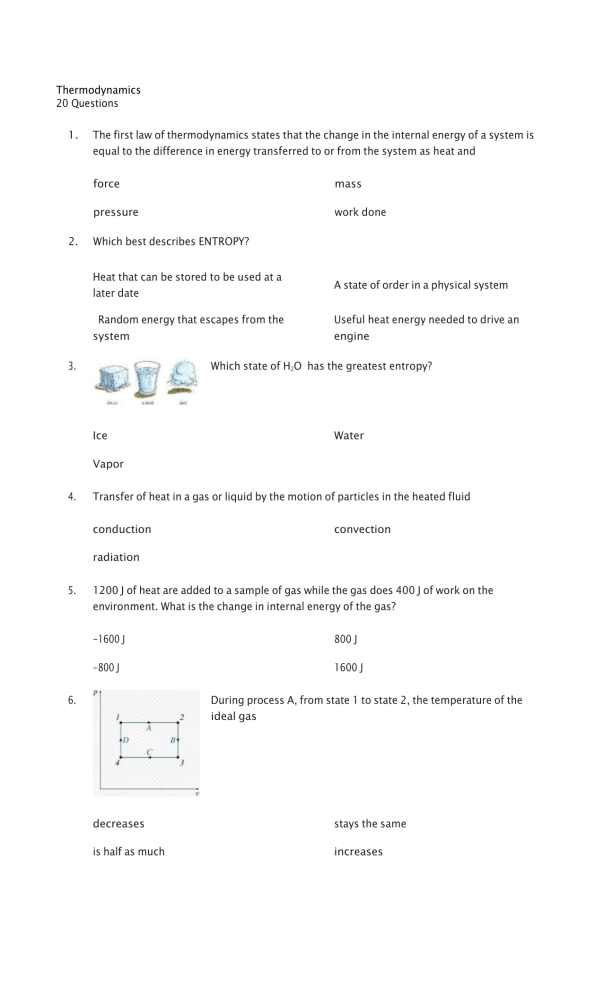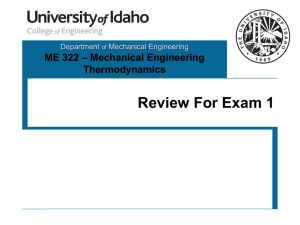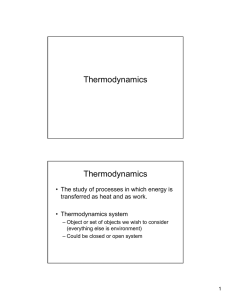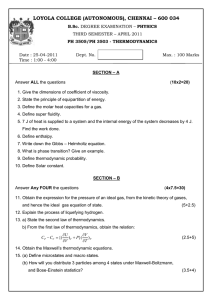
Thermodynamics 20 Questions 1. 2. The first law of thermodynamics states that the change in the internal energy of a system is equal to the difference in energy transferred to or from the system as heat and force mass pressure work done Which best describes ENTROPY? Heat that can be stored to be used at a later date A state of order in a physical system Random energy that escapes from the system Useful heat energy needed to drive an engine 3. Which state of H2O has the greatest entropy? Ice Water Vapor 4. Transfer of heat in a gas or liquid by the motion of particles in the heated fluid conduction convection radiation 5. 1200 J of heat are added to a sample of gas while the gas does 400 J of work on the environment. What is the change in internal energy of the gas? -1600 J 800 J -800 J 1600 J 6. During process A, from state 1 to state 2, the temperature of the ideal gas decreases stays the same is half as much increases 7. During an adiabatic process, a sample of gas does 400 J of work on the environment. What change occurs with the internal energy of the gas? The internal energy increases by 400 J. The internal energy decreases by 400 J. The internal energy doesn't change. There is not enough information if we don't know how much heat was added or removed. 8. 9. Process B on the PV diagram is an ____________ process. isothermal isobaric isochoric adiabatic A system comprising a single phase is called a (e) heterogeneous system. (d) homogeneous system (c) isolated system (b) open system (a) closed system 10. 11. 12. In an irreversible process, there is a (a) loss of heat (b) no loss of heat (c) gain of heat (d) no gain of heat. The heating and expanding of a gas is called (b) thermodynamic cycle (c) thermodynamic process (a) thermodynamic system (d) thermodynamic law. The value of one bar (in SI units) is equal to (a) 100 N/m2 (d) 1 × 105 N/m2 (c) 1 × 104 N/m2 (b) 1000 N/m2 (e) 1 × 106 N/m2. 13. In an extensive property of a thermodynamic system (d) all of the above (e) none of the above. (c) extensive energy is utilised (b) extensive work is done (a) extensive heat is transferred 14. 15. 16. 17. 18. 19. 20. Which of the following is an intensive property of a thermodynamic system ? (b) Temperature (d) Energy. (a) Volume (c) Mass When two bodies are in thermal equilibrium with a third body they are also in thermal equilibrium with each other. This statement is called (b) First law of thermodynamics (a) Zeroth law of thermodyamics (d) Kelvin Planck’s law. (c) Second law of thermodynamics 2.Internal energy depends on Only Volume Only Mass Only pressure Only Temperature 3. 1st Law of thermodynamics is the conservation of Electric energy Heat energy Radiation energy Magnetic energy 6. Area under P-V diagram gives Temperature Internal energy Heat Work done 7. Which of the following process is used to do maximum work done on the ideal gas if the gas is compressed to half of its initial volume? Isothermal Isochoric Adiabatic Isobaric 10. 1 Calorie is equal to 3.6 J 5.2J 4.2 J 3.2 J Answer Key 1.d 2.c 3.c 4.b 5.b 6.d 7.b 8.c 9.b 10.a 11.a 12.b 13.b 14.a 15.b 16.d 17.b 18.d 19.c 20.c







